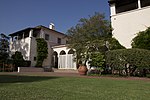The Einstein Papers Project (EPP) produces the historical edition of the writings and correspondence of Albert Einstein. The EPP collects, transcribes, translates, annotates, and publishes materials from Einstein's literary estate and a multitude of other repositories, which hold Einstein-related historical sources. The staff of the project is an international collaborative group of scholars, editors, researchers, and administrators working on the ongoing authoritative edition, The Collected Papers of Albert Einstein (CPAE).
The EPP was established by Princeton University Press (PUP) in 1977 at the Institute for Advanced Study. The founding editor of the project was professor of physics John Stachel. In 1984, the project moved from Princeton to Stachel's home institution, Boston University. The first volume of the CPAE was published by PUP in 1987. The following year, historian of science Martin J. Klein of Yale University was appointed senior editor of the project. Volumes 1-6 and 8 of the series were completed during the project's time in Boston.
In 2000, professor of history Diana Kormos-Buchwald was appointed general editor and director of the EPP and established offices for the project at the California Institute of Technology (Caltech) In Pasadena, California. Volumes 7 and 9-16 of the CPAE have been completed since the project's move to Caltech. (Volume 11 in the series is a comprehensive index and bibliography to Volumes 1-10).
The CPAE volumes include Einstein's books, his published and unpublished scientific and non-scientific articles, his lecture and research notebooks, travel diaries, book reviews, appeals, and reliable records of his lectures, speeches, interviews with the press, and other oral statements. The volumes also include his professional, personal, and political correspondence. Each annotated volume, referred to as the documentary edition, presents full text documents in their original language, primarily German. Introductions, endnotes, texts selected for inclusion as abstracts, etc. are in English. Volume 16 of the CPAE is the most recent publication in the series; the first sixteen volumes cover Einstein's life up to May 1929. PUP publishes the series. With each documentary edition, the EPP simultaneously publishes a companion English translation volume.
The EPP collaborates with the Albert Einstein Archives at the Hebrew University of Jerusalem. In his last will and testament, Einstein bequeathed his literary estate and his personal papers to the Hebrew University. The project and the archives maintain and update a shared archival database of 90,000+ records, freely accessible online. Support for the project comes from PUP, endowments from individuals and universities, the National Science Foundation, and the National Endowment for the Humanities.
In late 2014, the EPP and PUP launched The Digital Einstein Papers. The website presents the complete contents of The Collected Papers of Albert Einstein, Volumes 1-15. The project volumes are reproduced online as fully searchable PDFs. All documents and endnotes are linked to provide seamless transitions between the original language documentary edition and English translations. Subsequent volumes will be added to the website approximately eighteen months after their release in print. It is projected that there will be thirty volumes in the series. Eventually, the Digital Einstein Papers website will provide access to all of Einstein's writings and correspondence accompanied by scholarly annotation and apparatus.The Early Years: 1879-1902 is the first volume in the series.
The Swiss Years: 1900-1914 and The Berlin Years: 1914-1929 followed through volume 16 in two parallel and extensively cross-referenced branches:
Writings: published and previously unpublished articles, lecture notes, research notes, accounts of his lectures, speeches, interviews, book reviews, etc.
Correspondence: letters, travel diaries, calendars, documents about Einstein by third parties, etc.








